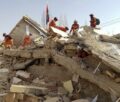When an industrial town showed the way

![]() In March 1987 some places in Madhya Pradesh witnessed communal clashes, but it redounded to the credit of the masses in both Bhopal and Ashta that they, by and large, refused to heed mischief-makers. Of course, there were cases of arson, but there was not a single case of stabbing or assault on any citizen. Additionally, after the withdrawal of curfew, Hindu and Muslim neighbours met freely and discussed frankly what had gone wrong in their towns.
In March 1987 some places in Madhya Pradesh witnessed communal clashes, but it redounded to the credit of the masses in both Bhopal and Ashta that they, by and large, refused to heed mischief-makers. Of course, there were cases of arson, but there was not a single case of stabbing or assault on any citizen. Additionally, after the withdrawal of curfew, Hindu and Muslim neighbours met freely and discussed frankly what had gone wrong in their towns.
But Pali, an industrial town in the same State, set an example worthy of emulation by the whole country. Though, following the riots, there was distrust between members of the two communities, there were several instances of Hindus and Muslims having helped each other even at the height of violence.
For instance, the Muslim Musafirkhana, the first place to invite the wrath of an angry mob, sheltered four Hindu families until it was safe for them to leave. Its manager, Mohammad Ismail, said it was a moment of truth for him.
“I could never have forgiven myself had something happened to the Hindus staying with us,” he said, and added, “several Hindu families also helped Muslims save themselves from rioters.”
Less than a decade ago Kashmir has started a totally new trend in resolution of communal conflicts. The picturesque temple town of Mattan, already a scene of communal violence, showed how clashing communities could be reunited.
Hindus and Muslims had been at daggers drawn ever since the outbreak of violence in the town twice in six months, following claims and counter-claims to a camping ground. The ice was broken when women belonging to both communities visited the houses of each other following a prolonged dialogue to iron out differences.
The dialogue had been initiated by the State government and involved both Hindus and Muslims. Meanwhile, the two stone idols stolen during riots from a temple in the neighbourhood were restored to the priests who reinstalled them.
In each one of the cases listed above there is a very strong undercurrent of communal harmony underscored by Sufi Islam and the Bhakti Cult.
Of course, the carnage in Gujarat in 2002, as also that in Mumbai in 1992-93, was carefully planned; even so in neither case was there an Armageddon.
Why?
The honest answer is that even in moments of fundamentalist fury, the sober precepts of the Bhakti Cult and Sufi Islam were not forgotten by a vast majority of Hindus and Muslims.
-
Book Shelf
-
 Book Review
DESTINY OF A DYSFUNCTIONAL NUCLEAR STATE
Book Review
DESTINY OF A DYSFUNCTIONAL NUCLEAR STATE
- Book ReviewChina FO Presser Where is the fountainhead of jihad?
- Book ReviewNews Pak Syndrome bedevils Indo-Bangla ties
- Book Review Understanding Vedic Equality….: Book Review
- Book Review Buddhism Made Easy: Book Review
- Book ReviewNews Elegant Summary Of Krishnamurti’s teachings
- Book Review Review: Perspectives: The Timeless Way of Wisdom
- Book ReviewNews Rituals too a world of Rhythm
- Book Review Marx After Marxism
- Book Review John Updike’s Terrorist – a review
-
-
Recent Top Post
-
 NewsTop Story
What Would “Total Victory” Mean in Gaza?
NewsTop Story
What Would “Total Victory” Mean in Gaza?
-
 CommentariesTop Story
The Occupation of Territory in War
CommentariesTop Story
The Occupation of Territory in War
-
 CommentariesTop Story
Pakistan: Infighting in ruling elite intensifies following shock election result
CommentariesTop Story
Pakistan: Infighting in ruling elite intensifies following shock election result
-
 CommentariesTop Story
Proforma Polls in Pakistan Today
CommentariesTop Story
Proforma Polls in Pakistan Today
-
 CommentariesTop Story
Global South Dithering Away from BRI
CommentariesTop Story
Global South Dithering Away from BRI
-
 News
Meherabad beckons….
News
Meherabad beckons….
-
 CommentariesTop Story
Hong Kong court liquidates failed Chinese property giant
CommentariesTop Story
Hong Kong court liquidates failed Chinese property giant
-
 CommentariesTop Story
China’s stock market fall sounds alarm bells
CommentariesTop Story
China’s stock market fall sounds alarm bells
-
 Commentaries
Middle East: Opportunity for the US
Commentaries
Middle East: Opportunity for the US
-
 Commentaries
India – Maldives Relations Nosedive
Commentaries
India – Maldives Relations Nosedive
-
AdSense code



















